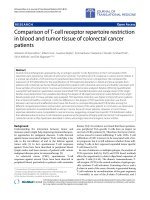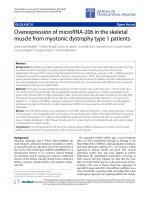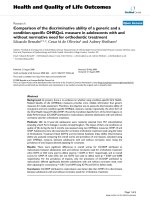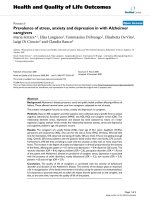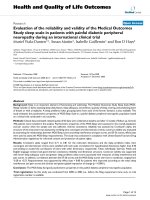Báo cáo hóa học: " Comparison of nickel silicide and aluminium ohmic contact metallizations for low-temperature quantum transport measurements" docx
Bạn đang xem bản rút gọn của tài liệu. Xem và tải ngay bản đầy đủ của tài liệu tại đây (298.01 KB, 5 trang )
NANO EXPRESS Open Access
Comparison of nickel silicide and aluminium
ohmic contact metallizations for low-temperature
quantum transport measurements
Craig M Polley
*
, Warrick R Clarke and Michelle Y Simmons
Abstract
We examine nickel silicide as a viable ohmic contact metallization for low-te mperature, low-magnetic-field
transport measurements of atomic-scale devices in silicon. In particular, we compare a nickel silicide metallization
with aluminium, a common ohmic contact for silicon devices. Nickel silicide can be formed at the low
temperatures (<400°C) required for maintaining atomic precision placement in donor-based devices, and it avoids
the complications found with aluminium contacts which become superconducting at cryogenic measurement
temperatures. Importantly, we show that the use of nickel silicide as an ohmic contact at low temperatures does
not affect the thermal equilibration of carriers nor contribute to hysteresis in a magnetic field.
Introduction
Aluminium has proven to be a versatile ohmic contact
metallization, and for a time was the preferred choice
for silicon integrated circuits [1]. Aluminium has al so
been a common contact metallization for a variety of
material systems such as gallium nitride [2], silicon car-
bide [3] and zinc oxide [4]. Owing to this versatility, alu-
minium has seen continued use in si licon-based
research, including recent quantum dot devices for the
study of quantum transport in silicon towards the goal
of solid-state quantum computation [5,6].
However the characterization of such devices typically
requires millikelvin temperatures, well below the nor-
mal-superconductor transition temperature of alumi-
nium, T
c
= 1.175 K [7]. Below this temperature, the
aluminium contacts form a Bardeen-Cooper-Schrieffer
(BCS) energy gap which manifests as an increased con-
tact resistance near B = 0. The contact resistance
increases exponentially as the temperature is reduced,
with important ramifications for studies at very low
temperatures and small magnetic fields. Such studies
include the measurement of electron-nuclear interac-
tions and dephasing times [8,9], which a re of critical
importance for development in quantum computation
[10-12]. Despite its versatility, aluminium is not an o pti-
mal metallization for low-temperature quantum trans-
port measurements. As a result, it is important to
consider alternative metallizations which do not undergo
a superconducting transition at low temperatures.
In this ar ticle we examine nickel silicide (Ni
x
Si
y
)asan
alternative ohmic contact metallization to silicon for use
at cryogenic temperatures. NiSi has already been inte-
grated into current CMOS processes because of its low
sheet resistivity and ability to form at narrow linewidths
[13]. It does not superconduct at any temperature and
has recently been used in low-temperature transport
measurements of a silicon nanowire quantum dot [14].
In addition, the silicide has the attractive property that
it can be formed at low-temperatures, with nickel rich
phases (e.g. Ni
2
Si) forming at tempe ratures below 350°C
[15]. This property is crucial for the fabrication of
atomic-precision donor-based devices where the aim is
to measure transport through atomically positioned sin-
gle dopants [ 16]. This imposes a low thermal b udget to
prevent diffusion of the dopants. In this article we
directly compare the electrical transport properties of
aluminium and nickel silicide ohmic contacts to satura-
tion dosed δ-layers of phosphorus in silicon. These δ-
layers are fabricated using identical processes to atomic-
scale devices patterned by scanning-tunnelling lit hogra-
phy [17]. We find that nickel silicide ohmic contacts
eliminate the zero-field resistance peak observed in
* Correspondence:
CQC
2
T, School of Physics, University of New South Wales, Sydney, NSW 2052,
Australia
Polley et al. Nanoscale Research Letters 2011, 6:538
/>© 2011 Polley et al; licensee Springer. This is an Open Access article distributed under the terms of the Creative Commons Attribution
License ( which permi ts unrestricted use, distribution, and repr oduction in any medium,
provided the or iginal work is properly cited .
aluminium contacts and do not introduce additional
hysteresis in a magnetic field.
Experiment
The devices were fabricated on a 1-10 Ωcm n-type Si
(100) substrate, annealed to 1100°C in UHV by direct
current heating to produce a 2 × 1 surface reconstruc-
tion. The surface was then δ-doped by saturation dosing
with 1.1 Langmuir of PH
3
gas at room temperature, fol-
low ed by a 350°C anneal to incorporate the phosphorus
into the silicon lattice [18]. After encapsulating with 30
nm of epitaxial silicon, the sample was remo ved from
UHV to be processed into Hall bar structures. This pro-
cess is known to result in 2D carrier densities of ≈ 2×
10
14
cm
-2
[19] with dopan t segregation confined to
approximately 0.6 nm [20].
Electron-beam lithography and reactive ion etching
were used to define the Hall bar mesas and ohmic con-
tacts. A buffered hydrofluoric acid etch was used to
remove the native oxide before the samples were loaded
into a high vacuum (4 × 10
-6
mbar) thermal evaporator.
For the aluminium Hall bars, 80 nm of Al was evapo-
rated followed by a 30-min anneal at ≈350°C in dry N
2
.
The nickel silicide Hall bars received 60 nm of Ni with
a 10-nm Ti capping layer to preven t oxidation [21]. The
sample was then annealed to 350°C in N
2
for 30 min to
yield the NiSi ph ase [15]. The unreacted nickel and tita-
nium were removed with a sulphuric acid- hydrogen
peroxide etch before Ti/Au (10/60 nm) bond pads were
patterned. The Ti/Au bilayer was required for successful
ultrasonic gold-ball bonding, and while bulk titanium
also has a superconducting transition at approximately
400 mK [22] it is known that in thin film superconduc-
tor-normal bilayers superconductivity is strongly sup-
pressed [23,24].
Initial magnetotransport characterization of these sam-
ples performed at 4.2 K revealed that both samples had
carrier densities of (1.4 ± 0.1) × 10
14
cm
-2
.Subsequent
millikelvin temperature measurements were performed
in a dilution refrigerator that allowed simultaneous mea-
surement of both samples with perpendicular fields up
to 8 T. Magnetotransport measurements were per-
formed using standard low-frequency lock-in techniques
with a 5 nA constant current.
Results
Figure 1 compares the field-dependent two-terminal resis-
tivities of the aluminium- and the nickel silicide-contacted
Hall bars. The small resistance peak in Figure 1a originates
from weak localization in the phosphorus δ-doped layer,
where electrons become locked into phase coherent loops
[25]. These loops are broken with the application of a per-
pendicular magnetic field, making the carriers available for
transport and reducing the resistivity of the δ-doped layer
for B > 0. The magnetoresistance can be well described by
the Hikami model for weak localization in a disordered 2D
system [26] as shown in Figure 1a, where the phase coher-
ence length of the system (i.e. the distance electrons travel
between phase randomizing scattering events) can be
obtained as a fitting parameter. For the fit in Figure 1a, we
obtain a phase coherence length of 450 nm, in agreement
with previous studies [27]. In contrast, the magn etoresis-
tance of the aluminium-contacted Hall bar in Figure 1b is
dominated by a large peak near B = 0 spanning B = ±10.5
mT, preventing fitting to the underlying weak localization
peak. This magnetic field range is consistent with the criti-
cal field B
C
for aluminium [7], confirming that the origin
of the peak is related to the BCS superconducting gap.
Figure 1 The two-terminal magnetoresistance at base
temperature (T≈50 mK) for aluminium and nickel silicide
contact metallizations to the Si:P δ-layers. Figure 1a shows a
small peak resulting from weak localization within the δ-layer, and
can be fitted with the Hikami model as shown. Figure 1b shows the
large resistance peak around B = 0 that results from the formation
of the BCS energy gap in the superconducting aluminium contacts.
The critical field B
C
= 10.5 mT for aluminium is shown, which
coincides with the destruction of the resistance peak.
Polley et al. Nanoscale Research Letters 2011, 6:538
/>Page 2 of 5
To further study the nature of this anomalous resis-
tance peak, we have performed temperature dependence
measurements as shown in Figure 2. The magnitude of
the peak is seen to rapidly increase as the temperature
is reduced. Whilst the BCS gap is known to increase
towards a limiting value of 3.52 kT
c
as the temperature
is reduced (≈ 360 μeV for aluminium), it changes only
weakly in the temperature range shown here (≈ 10%)
[28]. This is therefore unlikely to cause the exponential
increase in resistance shown in Figure 2. Instead we
attribute this t rend to the reduction of thermal energy
for carrier activation over the BCS energy gap. The
resistive peak continues to grow until T <200mK,at
which point the electron temperature begins to saturate.
Both the mobility and phase coherence length can be
extracted from four-terminal resistivity measurements,
which eliminate contact resistance and are therefore
unaffected by the two terminal resistance peaks at B =
0. The mobility, μ, is calculated directly from the mea-
sured zero-field resistivity according to the relation
μ =
1
n
s
eρ
. For highly disordered 2D systems, the phase
coherence l ength, l
j
, can be extracted by fitting the
weak-localization peak to the Hikami model near B =0,
as demonstrated in Figure 1a[26]. Figure 3 shows the
temperature dependence of both μ and the fitted values
of l
j
, and can be seen to be independent of the choice
of contact metallization. The obtained values are
commensurate with previous studies of δ-doped silicon
[27]. In this temperature regime, the mobility is domi-
nated by weak localization and electron-electron interac-
tions,whichbothresultinaln(T) dependence [29].
Electron dephasing is dominated by Nyquist scattering,
resulting in a T
-0.5
dependence for the phase coherence
length [29]. The nickel silicide Hall bar has a higher
mobility by ≈ 30%, which can be attributed to inhomo-
geneities in the initial δ- layer. For both samples, the
mobility and phase coherence length are observed to
saturate below T = 200 mK, confirming that the satura-
tion of the resistive peak observed in Figure 2 is simply
a consequence of the limiting electron temperature.
Importantly, the fact that both samples saturate at the
same temperature indicates that it is the refrigerator
and not the metallization which limits thermal equilibra-
tion of carriers.
Figure 2 Temperature dependence of the two-terminal
magnetoresistance for the aluminium contacted Hall bar from
base temperature to 800 mK. The inset illustrates the exponential
increase in the magnitude of the resistance peak, suggesting
thermal activation over the BCS energy gap.
Figure 3 Low-temperature magnetotransport properties of the
2D δ-layers as a function of temperature. Figure 3a shows the
phase coherence length as calculated from Hikami fitting while 3b
shows the mobility trend. The phase coherence length is
dominated by Nyquist dephasing, resulting in a T
-0.5
dependence,
shown in 3a. In this regime the mobility is dominated by weak
localization and electron-electron interactions, resulting in a net ln(T)
dependence as indicated in 3b. Importantly, the temperature
dependence of the mobility and phase coherence length is almost
identical for both samples indicating that neither metallization is
limiting the thermal equilibrium of carriers.
Polley et al. Nanoscale Research Letters 2011, 6:538
/>Page 3 of 5
Whilst pure nickel is ferr omagnetic, previous theoreti-
cal study has concluded that transition metal silicides
including NiSi are diamagnetic [30]. However previous
experimental results have indicated ambiguity in the
magnetic properties of NiSi for fields below 200 mT at
low temperatures [31]. It is therefore important to
determine whether the nickel silicide contacts used here
have any influence on the measured magnetic field
hysteresis.
We have measured the four-terminal magnetoresis-
tance for both metallizations as a function of magnetic
field for different magnetic field sweep rates as shown in
Figure 4. Particular care was taken to ensure that the
magnetic environment of each sample was identi cal. To
this end, the samples were measured sequentially (sev-
eral days apart) using the same package in the same
dilution refrigerator configuration. Magnetic hysteresis
is seen for both s amples with fast sweep rates of 0.2 T/
min, cooling the sample as the field sweeps towards B =
0 and heating as the field sweeps away from B = 0. This
is characteristic of adiabatic demagnetization of a fer ro-
magnetic material, where thermal and magnetic energies
are exchanged faster than the cryostat can equilibrate.
Figure 4 shows that the level of hysteresis is similar in
bothsamples,suggestingthatitistheferromagnetic
impurities in the immediate environment rather than
the ohmic contacts that are responsible for this effect.
For both samples, the hysteresis can be eliminated by
decreasing the magnetic field sweep rate to < 0.1 T/min
to allow sufficient time for the system to equilibrate.
We note that the slight difference in noise between Fig-
ure 4a,b is because of the different measurement elec-
tronics used for the second series of measurements.
Within each measure ment set the noise levels w ere
comparable between the samples.
Conclusions
We have compared the low-temperature magnetotran-
sport properties of highly doped Si:P δ-layers with both
nickel silicide and aluminium ohmic contacts. We have
shown that a nickel silicide contact is comparable to alu-
minium, with the added advantage that nickel silicide
does not transition to a superconducting state at low-
temperatures (T < 200 mK). This eliminates the contact
resistance peak around B = 0 observed with supercon-
ducting aluminium contacts, important for measure-
ments of electron-nuclear interactions and de-phasing
times. In addition, we have shown that nickel silicide
contacts neither alter the thermal equilibration of carriers
nor contribute to hysteresis in a varying magnetic field.
Acknowledgements
MYS acknowledges an Australian Government Federation Fellowship. WRC
acknowledges funding from the Australian Research Council in the form of
an Australian Post-Doctoral Fellowship.
Authors’ contributions
CMP fabricated and measured the samples and wrote the manuscript. WRC
and MYS assisted in experimental design, measurement, data analysis and
preparing the manuscript.
Competing interests
The authors declare that they have no competing interests.
Received: 17 May 2011 Accepted: 3 October 2011
Published: 3 October 2011
References
1. Card HC: Aluminum-Silicon Schottky barriers and ohmic contacts in
integrated circuits. IEEE Transactions on Electron Devices 1976, 23:538-544.
2. Liu QZ, Lau SS: A review of the metal-GaN contact technology. Solid-State
Electronics 1998, 42:677-691.
3. Crofton J, Porter LM, Williams JR: The physics of ohmic contacts to SiC.
Physica Status Solidi B 1997, 202:581-603.
4. Ozgur U, Alivov YI, Liu C, Teke A, Reshchikov MA, Dogan S, Avrutin V,
Cho SJ, Morkoc H: A comprehensive review of ZnO materials and
devices. Journal of Applied Physics 2005, 98:041301.
5. Fuechsle M, Mahapatra S, Zwanenburg FA, Friesen M, Eriksson MA,
Simmons MY: Spectroscopy of few-electron single-crystal silicon
quantum dots. Nature Nanotechnology 2010, 5:502.
6. Morello A, Pla JJ, Zwanenburg FA, Chan KW, Tan KY, Huebl H, Mottonen M,
Nugroho CD, Yang C, van Donkelaar JA, Alves ADC, Jamieson DN,
Escott CC, Hollenberg LCL, Clark RG, Dzurak AS: Single-shot readout of an
electron spin in silicon. Nature 2010, 467:687-691.
7. Caplan S, Chanin G: Critical-Field Study of Superconducting Aluminum.
Physical Review 1965, 138:A1428.
8. Eble B, Testelin C, Desfonds P, Bernardot F, Balocchi A, Amand T, Miard A,
Lemaitre A, Marie X, Chamarro M: Hole-Nuclear Spin Interaction in
Quantum Dots. Physical Review Letters 2009, 102(146601).
9. Laird EA, Barthel C, Rashba EI, Marcus CM, Hanson MP, Gossard AC: A new
mechanism of electric dipole spin resonance: hyperfine coupling in
quantum dots. Semiconductor Science and Technology 2009, 24(064004).
Figure 4 Dynamic hysteresis in the ma gnetoresistance
measured at base temperature. Figure 4a shows the hysteresis in
the magnetoresistance of the aluminium contacted Hall bar as a
function of magnetic field sweep rate. At a fast sweep rate of 0.2 T/
min clear hysteresis is observable, but disappears for sweep rates of
0.1 T/min or lower. Figure 4b shows the same results from a nickel
silicide contacted Hall bar. We see comparable behaviour, indicating
that the nickel silicidation process does not exacerbate the
hysteresis.
Polley et al. Nanoscale Research Letters 2011, 6:538
/>Page 4 of 5
10. Testelin C, Bernardot F, Eble B, Chamarro M: Hole-spin dephasing time
associated with hyperfine interaction in quantum dots. Physical Review B
2009, 79(195440).
11. Cywinski L, Witzel WM, Das Sarma S: Pure quantum dephasing of a solid-
state electron spin qubit in a large nuclear spin bath coupled by long-
range hyperfine-mediated interactions. Physical Review B 2009,
79(245314).
12. Kane BE: A silicon-based nuclear spin quantum computer. Nature 1998,
393:133-137.
13. Lavoie C, d’Heurle FM, Detavernier C, Cabral C Jr: Towards implementation
of a nickel silicide process for CMOS technologies. Microelectronic
Engineering 2003, 70:144.
14. Zwanenburg F, van Rijmenam C, Fang Y, Lieber C, Kouwenhoven L: Spin
states of the first four holes in a silicon nanowire quantum dot. Nano
Letters 2009, 9:1071.
15. Waidmann S, Kahlert V, Streck C, Press P, Kammler T, Dittmar K, Zienert I,
Rinderknecht J: Tuning nickel silicide properties using a lamp based RTA,
a heat conduction based RTA or a furnace anneal. Microelectronic
Engineering 2006, 83:2282.
16. Schofield SR, Curson NJ, Simmons MY, Ruess FJ, Hallam T, Oberbeck L,
Clark RG: Atomically precise placement of single dopants in Si. Physical
Review Letters 2003, 91:136104.
17. Simmons MY, Ruess FJ, Goh KEJ, Pok W, Hallam T, Butcher MJ, Reusch TCG,
Scappucci G, Hamilton AR, Oberbeck L: Atomic-scale silicon device
fabrication. International Journal Of Nanotechnology 2008, 5:352.
18. Wilson HF, Warschkow O, Marks NA, Curson NJ, Schofield SR, Reusch TCG,
Radny MW, Smith PV, McKenzie DR, Simmons MY: Thermal dissociation
and desorption of PH3 on Si(001): A reinterpretation of spectroscopic
data. Physical Review B 2006, 74:195310.
19. McKibbin SR, Clarke WR, Fuhrer A, Reusch TCG, Simmons MY: Investigating
the regrowth surface of Si: P δ-layers toward vertically stacked three
dimensional devices. Applied Physics Letters 2009, 95:233111.
20. Oberbeck L, Curson NJ, Hallam T, Simmons MY, Bilger G, Clark RG:
Measurement of phosphorus segregation in silicon at the atomic scale
using scanning tunneling microscopy. Applied Physics Letters 2004,
85:1359.
21. Tan WL, Pey KL, Chooi SYM, Ye JH, Osipowicz T: Effect of a titanium cap in
reducing interfacial oxides in the formation of nickel silicide. Journal of
Applied Physics 2002, 91:2901.
22. Peruzzi A, Gottardi E, Pavese F, Peroni I, Ventura G: Investigation of the
titanium superconducting transition as a temperature reference point
below 0.65 K. Metrologia 2000,
37:229.
23. De Gennes PG: Boundary Effects in Superconductors. Reviews of Modern
Physics 1964, 36:225.
24. Baselmans JJA, van Wees BJ, Klapwijk TM: 2001.
25. Abrahams E, Anderson P, Licciardello D, Ramakrishnan T: Scaling theory of
localization: Absence of quantum diffusion in two dimensions. Physical
Review Letters 1979, 42:673.
26. Hikami S, Larkin AI, Nagoka Y: Spin-Orbit Interaction and
Magnetoresistance in the Two-Dimensional Random System. Progress of
Theoretical Physics 1980, 63:707.
27. Goh KEJ: Encapsulation of Si:P devices fabricated by scanning tunnelling
microscopy. PhD thesis University of New South Wales; 2006.
28. Bardeen J, Cooper LN, Schrieffer JR: Theory of Superconductivity. Physical
Review 1957, 108:1175.
29. Goh KEJ, Simmons MY, Hamilton AR: Electron-electron interactions in
highly disordered two-dimensional systems. Physical Review B 2008,
77:235410.
30. Wu H, Kratzer P, Scheffer M: First-principles study of thin magnetic
transition-metal silicide films on Si(001). Physical Review B 2005,
72:144425.
31. Meyer B, Gottlieb U, Laborde O, Yang H, Lasjaunias J, Sulpice A, Madar R:
Intrinsic properties of NiSi. Journal of Alloys amd Compounds 1997,
262:235.
doi:10.1186/1556-276X-6-538
Cite this article as: Polley et al.: Comparison of nickel silicide and
aluminium ohmic contact metallizations for low-temperature quantum
transport measurements. Nanoscale Research Letters 2011 6:538.
Submit your manuscript to a
journal and benefi t from:
7 Convenient online submission
7 Rigorous peer review
7 Immediate publication on acceptance
7 Open access: articles freely available online
7 High visibility within the fi eld
7 Retaining the copyright to your article
Submit your next manuscript at 7 springeropen.com
Polley et al. Nanoscale Research Letters 2011, 6:538
/>Page 5 of 5




